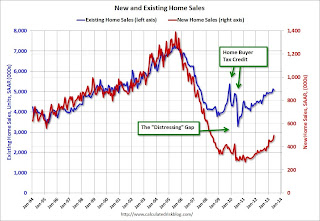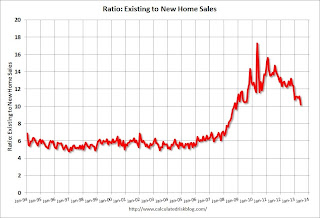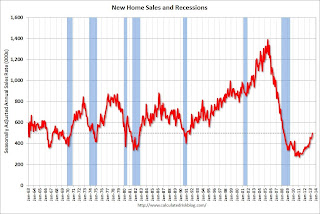From Calculated Risk:
A Few Comments on New Home Sales
Posted: 24 Jul 2013 08:30 AM PDT
As I noted over the weekend, the key number in the existing home sales report is not sales, but inventory. It is mostly visible inventory that impacts prices. When we look at sales for existing homes, the focus should be on the composition between conventional and distressed, not total sales. So, for those who follow housing closely, the existing home sales report on Monday was solid even though sales were down.
However, for the new home sales report, the key number IS sales! An increase in sales adds to both GDP and employment (completed inventory is at record lows, so any increase in sales will translate to more single family starts). So sales in June at 497 thousand SAAR were very solid (the highest sales rate since May 2008). The housing recovery is ongoing.
Earlier: New Home Sales at 497,000 Annual Rate in June
Looking at the first half of 2013, there has been a significant increase in sales this year. The Census Bureau reported that there were 244 new homes sold in the first half of 2013, up 28.4% from the 190 thousand sold during the same period in 2012. This was the highest sales for the first half of the year since 2008.
And even though there has been a large increase in the sales rate, sales are just above the lows for previous recessions. This suggests significant upside over the next few years. Based on estimates of household formation and demographics, I expect sales to increase to 750 to 800 thousand over the next several years - substantially higher than the current sales rate.
And an important point worth repeating every month: Housing is historically the best leading indicator for the economy, and this is one of the reasons I think The future's so bright, I gotta wear shades.
And here is another update to the "distressing gap" graph that I first started posting over four years ago to show the emerging gap caused by distressed sales. Now I'm looking for the gap to close over the next few years.
 Click on graph for larger image. Click on graph for larger image.
The "distressing gap" graph shows existing home sales (left axis) and new home sales (right axis) through June 2013. This graph starts in 1994, but the relationship has been fairly steady back to the '60s.
Following the housing bubble and bust, the "distressing gap" appeared mostly because of distressed sales. The flood of distressed sales kept existing home sales elevated, and depressed new home sales since builders weren't able to compete with the low prices of all the foreclosed properties.
I don't expect much of an increase in existing home sales (distressed sales will slowly decline and be offset by more conventional sales). But I do expect this gap to continue to close - mostly from an increase in new home sales.
 Another way to look at this is a ratio of existing to new home sales. Another way to look at this is a ratio of existing to new home sales.
This ratio was fairly stable from 1994 through 2006, and then the flood of distressed sales kept the number of existing home sales elevated and depressed new home sales. (Note: This ratio was fairly stable back to the early '70s, but I only have annual data for the earlier years).
In general the ratio has been trending down - and is currently at the lowest level since November 2008. I expect this ratio to continue to trend down over the next several years as the number of distressed sales declines and new home sales increase.
Note: Existing home sales are counted when transactions are closed, and new home sales are counted when contracts are signed. So the timing of sales is different.
|
New Home Sales at 497,000 Annual Rate in June
Posted: 24 Jul 2013 07:15 AM PDT
The Census Bureau reports New Home Sales in June were at a seasonally adjusted annual rate (SAAR) of 497 thousand. This was up from 459 thousand SAAR in May (May sales were revised down from 476 thousand).
March sales were revised down from 451 thousand to 443 thousand, and April sales were revised down from 466 thousand to 453 thousand.
The first graph shows New Home Sales vs. recessions since 1963. The dashed line is the current sales rate.
"Sales of new single-family houses in June 2013 were at a seasonally adjusted annual rate of 497,000, according to estimates released jointly today by the U.S. Census Bureau and the Department of Housing and Urban Development. This is 8.3 percent above the revised May rate of 459,000 and is 38.1 percent above the June 2012 estimate of 360,000."  Click on graph for larger image in graph gallery. Click on graph for larger image in graph gallery.
The second graph shows New Home Months of Supply.
The months of supply decreased in June to 3.9 months from 4.2 months in May.
The all time record was 12.1 months of supply in January 2009.
 This is now in the normal range (less than 6 months supply is normal). This is now in the normal range (less than 6 months supply is normal).
"The seasonally adjusted estimate of new houses for sale at the end of June was 161,000. This represents a supply of 3.9 months at the current sales rate." On inventory, according to the Census Bureau:
"A house is considered for sale when a permit to build has been issued in permit-issuing places or work has begun on the footings or foundation in nonpermit areas and a sales contract has not been signed nor a deposit accepted." Starting in 1973 the Census Bureau broke this down into three categories: Not Started, Under Construction, and Completed.
 This graph shows the three categories of inventory starting in 1973. This graph shows the three categories of inventory starting in 1973.
The inventory of completed homes for sale is at a record low. The combined total of completed and under construction is also just above the record low.
The last graph shows sales NSA (monthly sales, not seasonally adjusted annual rate).
In June 2013 (red column), 48 thousand new homes were sold (NSA). Last year 34 thousand homes were sold in June. The high for June was 115 thousand in 2005, and the low for June was 28 thousand in 2010 and 2011.

This was above expectations of 481,000 sales in June, and a solid report even with the downward revisions to previous months. I'll have more later today.
|
MBA: Mortgage Applications decrease slightly in Latest Weekly Survey
|










